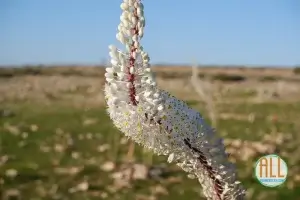Contenidos del artículo
If you have been in Formentera from the end of August to the end of September, you may have seen quite a few onions in bloom on the island, with stems that reach up to one and a half meters in height.
Did you know that it is a toxic onion that can even kill a human being and that it has been used for centuries as a poison and for its medicinal properties?
In this post we are going to give you all the information about what is commonly known as squill onion or sea onion.
Description, uses and dangers of squill onion

The squill onion or sea onion, whose scientific name is Drimia Maritima, is a bulbous plant of the genus Drimia. It includes approximately 100 species that are distributed throughout the Mediterranean area, India, Africa and Madagascar.
Although it may seem that it is a common onion, or that it seems very related to them, it is necessary to clarify that the onions that are grown for human consumption are part of the genus Allium, belonging to the same family as squill onions (Asparegaceae) but classified in a different genus (the genus Drimia).
Plant characteristics
It is a plant with a large bulb (up to 20 cm in diameter) buried or semi-buried. In fact, it is common for the top of the bulb to not be underground. The different layers of the bulb have different colors, which can range from white, gray to purple, which makes many people believe that it is simply a common wild onion.
Being a plant adapted to the Mediterranean climate, it resists drought very well and the bulb acts as a reserve of carbohydrates and water for the plant when weather conditions are not suitable.
In the Mediterranean area, and specifically in Formentera, the plant blooms between the end of August and the end of October, so it is common to see many stems of the squill flower in the fields during this time, which can have up to 1.5 meters high.
What are the flowers like?
The flowers of the squill appear at the end of the stem. There can be up to 40 flowers on the stem or more, and these flowers are white. The colors of the flowers can vary from white to gray, but specifically in Formentera they are usually white with the stamen (the pollen sac) triangular and yellow.
Toxicity and dangers
The squill is extremely toxic and poisonous. The main compound that makes squill so toxic is scylyroside. Sciliroside is cardiotonic, or in other words, it interferes with the proper functioning of the heart muscle in most mammals. The effects of poisoning include cardiac dysfunction and fibrillation, kidney and digestive disorders and, in the worst case, cardiac arrest.
The entire plant is poisonous, but the highest concentration of toxins is found in the bulb: consuming between 0.1 and 1.5 g of the squill bulb can cause death.
Use of its toxins
Although the plant is highly toxic, this has not stopped humans from using its properties for traditional medicine and other uses.
The squill onion has been cultivated since at least the times of ancient Egypt (2,000 BC) and its uses, if correctly dosed, are:
- Used as a cardiac tonic
- As a diuretic to treat edema and nephritis
- To make insecticides
- It is grown commercially to use its poison to make rodenticides
Images in detail
Some images of the many squill onions that you can find in Formentera are the following. Remember for your safety not to manipulate the plant.





